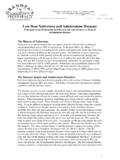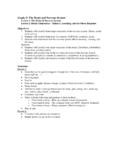Transcription of How air conditioning works - Conservation physics
1 How air conditioning worksThe essential ingredients in an air conditioning system are a fan to blow air around, a coldsurface to cool and dehumidify the air, a warm surface and a source of water vapour. In alarge system there will also be a tangle of tubes to distribute the air and collect it again. Notice that the cold surface has two independent jobs to do: it is used to cool the air and it isalso used to dehumidify, by condensing water from the air. This means that the air is cooledmore than is necessary for temperature control, so that it must be heated again afterwards. Air conditioning wastes energy. It also wastes space, because air has to be pumped around inquite large tubes, so that it doesn't make a rushing noise. It does, nevertheless, generate adisturbing background noise if the room is otherwise quiet.
2 There is worse news to come: airconditioning is spreading to more and more buildings in climates that we once thought were somild that they would be immune. The origin of this technological epidemic is not the subject of this article. I will howevermention some reasons which are relevant to museum conservators. Modern museums, and oldones as well, are showpieces designed to be admired for bold and original architecture. Theytend to be massive, and those old museums which originally had courtyards to give light andair are now glassed over with domes and atria. The heat and moisture cannot easily escape tothe outside: they have now to be pumped out. The subtle elegance of buildings designed for their purpose counts for little nowadays. GrandGestures are fashionable, and air conditioning hides the architects' and engineers' lack ofunderstanding or respect for natural ventilation.
3 One must say that conservators havereinforced this trend, because they have set specifications for allowable variation oftemperature and relative humidity that can only be achieved by mechanical air conditioning . 1 The purpose of this article is to explain how air conditioning works , in order to show why onecannot just pluck values from some standard or recommendation without risking unexpectedpenalties in energy use, maintenance cost and noise. Furthermore, once the mess of steel boxesand ducts is installed, you cannot dial the temperature and humidity exactly as you want themwithout risking surprisingly expensive side effects of energy consumption, climatic instabilityand hidden condensation. I will describe two typical systems. The first is air conditioning for a single room, the second isa full system for a large building.
4 Most of the available literature, particularly on the internet,takes it for granted that air conditioning is a good thing and then proceeds to tell you how todesign it. This article is designed to help you understand other people's designs, and judgetheir suitability for your purpose. Simple air conditioningA fan draws air from the room first through a cooling device, consisting of metal finsextending from a pipe through which cooling fluid circulates, at a rate determined by the thermostat or by the humidistat. The air next passes over a heater, usually electrical, which isenergised on instructions from the room thermostat. Figure 2. Minimal air conditioning . The part of the system in the room, on the left, pulls airfirst over a cool surface and then over a warming surface. The part of the system on the rightrecirculates the cooling fluid.
5 The fluid passes from the reservoir through a valve B into thelower pressure within the cooling unit in the room. There the liquid boils, removing heat fromthe air. The boiling point is fixed by the constant pressure set by valve A. The vapour is thencompressed and condensed back into a liquid which collects in the reservoir ready foranother cycle. 2 Air conditioning has in the past been used where the climate is too hot for comfort. Coolingwill increase the relative humidity of the air, so humidification is not usually built into thesesystems. If it is necessary, the usual method is to inject steam from electrically boiled is all there is to the part of the system in the room, which is sketched on the left in figure2. The bit that is more difficult to understand, or at least unfamiliar to most people, is how thecooling fluid is produced and controlled.
6 That is the part on the right of the cooling fluid used to be a chlorofluorocarbon compound, and often still is, though they allmore or less ravage the earth's ozone layer. The essential characteristics of these fluids is thatthey have quite a low boiling point at atmospheric pressure and that they can stay in the pipesfor a long time without decomposing either themselves or the pipes. Finally they need to havesome lubricating ability, or the ability to carry a lubricant, because the fluid has to becompressed and pumped round the system . This rare set of necessary properties has proveddifficult to combine with friendliness to the earth's atmosphere. The liquid is let into the cooling unit through a valve marked B on the diagram. It evaporateswhile it passes through the pipe, taking heat from the air just as water evaporating from atowel laid on your fevered brow cools you when on holiday in the Mediterranean.
7 Thetemperature in the cooling coil depends partly on the amount of fluid let in by the valve, whichis controlled by the thermostat or the humidistat. But now comes a crucial difference fromyour Mediterranean experience: the minimum temperature at the cold surface can be fixed bycontrolling the pressure in the cooling coil, with the valve marked A on the diagram. Theboiling point of any liquid depends on the pressure. One could use water in the cooling coil, ifthe pressure is kept low enough. At 1000 Pa pressure, which seems a lot but is just 1% ofatmospheric pressure, water boils at 7 degrees. It isn't used in cooling coils of this evaporativetype because it has practical reason for wanting to limit the minimum temperature is to stop ice clogging the airpassage. There are clever systems which notice when ice has formed and hold a melting pause,but that adds to the cost.
8 The pressure controller is therefore set to make the cooling fluid boilat the lowest temperature that is likely to be needed to control the humidity, but always overzero degrees. The temperature needed for cooling is nearly always higher than that needed fordehumidification so it is the RH setting that is decisive. This brings me to the first point that conservators need to understand: it is expensive toproduce air at a dew point below about 4 degrees in this type of equipment. Thisdewpoint corresponds to 50% RH at 15 C. This sort of air conditioning is entirely suitable forkeeping people comfortable but it is not good for specialised stores, for films or for furs, forexample, where one needs a temperature below 15 degrees. Such equipment is, however,often used for such places.
9 A better solution is to use an absorption dehumidifier, which willbe described in a later back to the main story: The vapour that emerges through the pressure controller isgathered up by a compressor. The compression also heats the gas, as will be understood byanyone who has pumped up a cycle tyre. The hot gas is then led away from the room, to becooled down. This is often done on the roof or in a small enclosure which vibrates to the roarof the fan blowing air over the fins of a condenser. The cooled, now liquid coolant is pipedback to the reservoir, ready for its next tour through the room air entire process described above is inefficient and uses electricity, which is itself producedby inefficient conversion of heat energy. Such systems are therefore confined to small placeswhere the inefficiency is compensated by the generally high reliability and freedom frommaintenance.
10 Large air conditioning systemsFigure 3. A large air conditioning system functions much like that described in figure 2,except that chilled water is used to cool the air. Outside air is drawn in, filtered and heatedbefore it passes through the main air conditioning devices. The coloured lines in the lowerpart of the diagram show the changes of temperature and of water vapour concentration (notRH) as the air flows through the system . The principle of operation is the same as that of the small system described above except thatthe cooling fluid is usually water, which has itself been cooled by the refrigeration systemdescribed above. The air is circulated through ducts, with a portion of fresh air added. There is4therefore a pre-heater, because the outside air may be below zero and will therefore freeze thewater in the cooling coil.










